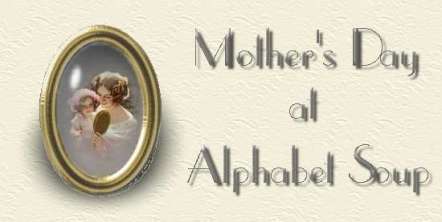Mj’z Profile
Name:MARY JOY BENOSA
Course:COMPUTER PROGRAMMING
Age:19 yrs.old
Address:ROXAS CITY
Email:maryjoybenosa@hotmail.com
Mother’s Day
Mother’s Day is a special day for everyone! We use this day to honor our mothers all over the world! 
Hundreds of shells on the shore together,
Hundreds of birds that go singing by,
Hundreds of lambs in the sunny weather.
Hundreds of bees in the purple clover,
Hundreds of butterflies on the lawn,
But only one mother the world wide over.
Chrismas Time
|
|
The History of Christmas |
 |
|
In the Western world, the birthday of Jesus Christ has been celebrated on December 25th since AD 354, replacing an earlier date of January 6th. The Christians had by then appropriated many pagan festivals and traditions of the season, that were practiced in many parts of the Middle East and Europe, as a means of stamping them out. There were mid-winter festivals in ancient Babylon and Egypt, and Germanic fertility festivals also took place at this time. The birth of the ancient sun-god Attis in Phrygia was celebrated on December 25th, as was the birth of the Persian sun-god, Mithras. The Romans celebrated Saturnalia, a festival dedicated to Saturn, the god of peace and plenty, that ran from the 17th to 24th of December. Public gathering places were decorated with flowers, gifts and candles were exchanged and the population, slaves and masters alike, celebrated the occasion with great enthusiasm. In Scandinavia, a period of festivities known as Yule contributed another impetus to celebration, as opposed to spirituality. As Winter ended the growing season, the opportunity of enjoying the Summer’s bounty encouraged much feasting and merriment. The Celtic culture of the British Isles revered all green plants, but particularly mistletoe and holly. These were important symbols of fertility and were used for decorating their homes and altars.New Christmas customs appeared in the Middle Ages. The most prominent contribution was the carol, which by the 14th century had become associated with the religious observance of the birth of Christ. In Italy, a tradition developed for re-enacting the birth of Christ and the construction of scenes of the nativity. This is said to have been introduced by Saint Francis as part of his efforts to bring spiritual knowledge to the laity. Saints Days have also contributed to our Christmas celebrations. A prominent figure in today’s Christmas is Saint Nicholas who for centuries has been honored on December 6th. He was one of the forerunners of Santa Claus. Another popular ritual was the burning of the Yule Log, which is strongly embedded in the pagan worship of vegetation and fire, as well as being associated with magical and spiritual powers. Celebrating Christmas has been controversial since its inception. Since numerous festivities found their roots in pagan practices, they were greatly frowned upon by conservatives within the Church. The feasting, gift-giving and frequent excesses presented a drastic contrast with the simplicity of the Nativity, and many people throughout the centuries and into the present, condemn such practices as being contrary to the true spirit of Christmas.The earliest English reference to December 25th as Christmas Day did not come until 1043. |
All Saint’s Day
When I was a child, my parents helped me celebrate all of the holidays. I really enjoyed Halloween but I really did not quite get the All saint’s Day celebration. Now many, many years later, I look back and see that as my belief in God and my faith as a Christian matured, I then began to understand the wonderful celebration of All Saints. As a child All Saints was a holy day of obligation. As a mature adult, All Saints Day is a special day when we remember all people who have served God faithfully, The Gospel for the day is the beatitudes. The gospel for “a saint’s day” is:“…Then the King will say to those on his right, ‘Come, you who are blessed by my Father; take your inheritance, the kingdom prepared for you since the creation of the world. For I was hungry and you gave me something to eat, I was thirsty and you gave me something to drink, I was a stranger and you invited me in, I needed clothes and you clothed me, I was sick and you looked after me, I was in prison and you came to visit me.’
“Then the righteous will answer him, ‘Lord, when did we see you hungry and feed you, or thirsty and give you something to drink? When did we see you a stranger and invite you in, or need clothes and clothe you? When did we see you sick or in prison and go to visit you?’
“The King will reply, ‘I tell you the truth, whatever you did for one of the least of these brothers of mine, you did for me.’
Need I say more. Well, maybe. When I was a child I thought that this would be easy. It has not been easy. To do good is not as easy as it seems. But I can say this. I watched as my mother grew older and matured and grew in grace. She grew in love and compassion as she aged. I think there is hope for you and me if only we hold to the course.
We must be able to change and grow. We must be able to listen to God first and people second. People are sometimes wrong.
On this November 1, think of those whom you have known. Think of those who were close to God. Think of those who served God and have passed to the next life.
Say a prayer for them and yourself. Or maybe go to an All Saints Day service. You will find them in the Lutheran, Episcopal and Catholic Churches. Some Methodist churches also celebrate All Saints. Go to a church that celebrates with Holy Communion. That will make it very special. Remember, it is believed by the faithful that when you go to the communion rail, you join with all the saints and souls of the dear departed in praise and worship of God. At that moment, you kneel with all departed faithful members of your family.
What a celebration !
Happy Father’s Day
QUOTES ABOUT DAD

“A father is always making his baby into a little woman. And when she is a woman he turns her back again.” — Enid Bagnold
“It no longer bothers me that I may be constantly searching for father figures; by this time, I have found several and dearly enjoyed knowing them all.” — Alice Walker
“None of you can ever be proud enough of being the child of SUCH a Father who has not his equal in this world-so great, so good, so faultless.
Try, all of you, to follow in his footsteps and don’t be discouraged, for to be really in everything like him none of you, I am sure, will ever be. Try, therefore, to be like him in some points, and you will have acquired a great deal.” — Victoria, Queen of England
“That is the thankless position of the father in the family-the provider for all, and the enemy of all.” — J. August Strindberg
“It is a wise father that knows his own child.” — William Shakespeare
“It doesn’t matter who my father was; it matters who I remember he was.” — Anne Sexton
“One father is more than a hundred schoolmasters.” — English Proverb
“To be a successful father . . . there’s one absolute rule: when you have a kid, don’t look at it for the first two years.” — Ernest Hemingway
“A man knows when he is growing old because he begins to look like his father.” — Gabriel García Márquez
“I cannot think of any need in childhood as strong as the need for a father’s protection.” — Sigmund Freud
“I watched a small man with thick calluses on both hands work fifteen and sixteen hours a day. I saw him once literally bleed from the bottoms of his feet, a man who came here uneducated, alone, unable to speak the language, who taught me all I needed to know about faith and hard work by the simple eloquence of his example.” — Mario Cuomo
“Be kind to thy father, for when thou wert young,
Who loved thee so fondly as he?
He caught the first accents that fell from thy tongue,
And joined in thy innocent glee.”
— Margaret Courtney
“If the new American father feels bewildered and even defeated, let him take comfort from the fact that whatever he does in any fathering situation has a fifty percent chance of being right.” — Bill Cosby
Love at first sight…
 In the classical world, the phenomenon of “love at first sight” was understood within the context of a more general conception of passionate love, a kind of madness or, as the Greeks put it, theia mania (“madness from the gods”).[1] This love passion was described through an elaborate metaphoric and mythological psychological schema involving “love’s arrows” or “love darts”, the source of which was often given as the mythological Eros or Cupid,[2], sometimes by other mythological deities (such as Rumor[3]). At times, the source of the arrows was said to be the image of the beautiful love object itself. If these arrows were to arrive at the lover’s eyes, they would then travel to and ‘pierce’ and ‘wound’ his or her heart and overwhelm him/her with desire and longing (love sickness). The image of the “arrow’s wound” was sometimes used to create oxymorons and rhetorical antithesis concerning its pleasure and pain.
In the classical world, the phenomenon of “love at first sight” was understood within the context of a more general conception of passionate love, a kind of madness or, as the Greeks put it, theia mania (“madness from the gods”).[1] This love passion was described through an elaborate metaphoric and mythological psychological schema involving “love’s arrows” or “love darts”, the source of which was often given as the mythological Eros or Cupid,[2], sometimes by other mythological deities (such as Rumor[3]). At times, the source of the arrows was said to be the image of the beautiful love object itself. If these arrows were to arrive at the lover’s eyes, they would then travel to and ‘pierce’ and ‘wound’ his or her heart and overwhelm him/her with desire and longing (love sickness). The image of the “arrow’s wound” was sometimes used to create oxymorons and rhetorical antithesis concerning its pleasure and pain.
“Love at first sight” was explained as a sudden and immediate beguiling of the lover through the action of these processes. “Love at first sight” occurs in numerous Greek and Roman works. In Ovid‘s Metamorphoses, Narcissus becomes immediately spellbound and charmed by his own (unbeknownst to him) image. In Achilles Tatius‘s Leucippe and Clitophon, the lover Clitophon describes his own experience of the phenomenon thusly: “As soon as I had seen her, I was lost. For Beauty’s wound is sharper than any weapon’s, and it runs through the eyes down to the soul. It is through the eye that love’s wound passes, and I now became a prey to a host of emotions…”[4] “Love at first sight” was not, however, the only mode of entering into passionate love in classical texts; at times the passion could occur after the initial meeting or could precede the first glimpse.
Another classical interpretation of the phenomenon of “love at first sight” could be found in Plato‘s Symposium in Aristophanes‘ description of the separation of primitive double-creatures into modern men and women and their subsequent search for their missing half: “… when [a lover] … is fortunate enough to meet his other half, they are both so intoxicated with affection, with friendship, and with love, that they cannot bear to let each other out of sight for a single instant.” [5]




